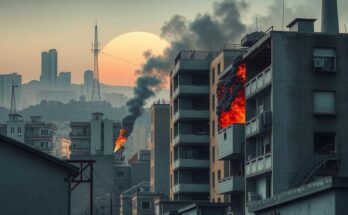The conflict in eastern DRC, particularly in Goma, revolves around economic rivalry and ethnic tensions, exacerbated by the M23 rebel group’s recent territorial gains. The fighting has resulted in significant civilian casualties and displacement, with over 26 million people requiring humanitarian assistance. The quest for control over rich mineral resources complicates the situation, prompting allegations of foreign support for armed groups, while civilians suffer the most from the ongoing unrest.
Economic competition and ethnic strife are central to the ongoing conflict in the eastern Democratic Republic of Congo (DRC), where Goma, a strategically significant city, has recently succumbed to rebel control. The M23 rebel group, allegedly receiving foreign support, claims to protect the rights of ethnic Tutsis while intensifying its military campaigns. The struggle for dominance in this mineral-rich region has resulted in extensive displacement and casualties, exacerbating the humanitarian crisis.
In recent weeks, the conflict has escalated significantly with Goma, home to over 3 million residents and adjacent to Rwanda, becoming a focal point of fighting. M23, claiming “total control” of Goma, underscores the volatile situation, despite government denials. Clashes between the Congolese army, supported by UN peacekeepers, and rebel forces have led to numerous deaths and injuries, with civilians suffering the most from ongoing violence.
Notably, Goma’s strategic importance stems from its proximity to vast mineral resources, making it a prime target in conflicting local interests. Historical tensions between various ethnic groups within Goma complicate the dynamics, as local militias vie for control over land and valuable mining territories. These conflicts are underpinned by economic motives, further fueled by the immense mineral wealth of eastern Congo.
The M23 group emerged from a previous rebel faction and advocates for the rights of Tutsis in the region while accusing the Congolese government of neglecting their safety and integration concerns. The turmoil also has its roots in the aftermath of the 1994 Rwandan genocide, which significantly influenced regional dynamics. Both Rwanda and Uganda are accused of supporting rebel groups in eastern Congo, yet they maintain that they face their own security threats from these factions.
Eastern Congo has become a battleground for over 100 armed groups, primarily fueled by the desire for control over lucrative mineral reserves. Analysts indicate that external influences and interests in extractive industries significantly contribute to the sustained unrest, notably involving illegal mineral trafficking worth billions. This mineral wealth shapes the conflict and influences foreign involvement, perpetuating cycles of violence.
The humanitarian situation in Goma is dire, with over 26 million Congolese needing assistance. The ongoing violence has overwhelmed local healthcare facilities, disrupted basic utilities, and worsened food shortages due to blocked access routes. Internally displaced populations are increasing, creating immense pressure on already strained resources, with various organizations raising alarms over the imminent dangers of famine and lack of support for displaced persons.
The crisis in the eastern DRC is a complex interplay of economic interests, ethnic divisions, and historical conflicts. Goma’s strategic location has made it a critical point in local power struggles, particularly concerning access to natural resources integral to modern technology. The legacy of the Rwandan genocide further complicates these dynamics, fostering longstanding tensions that fuel present conflicts.
The Goma crisis illustrates the deep-rooted issues of conflict in eastern DRC, where economic competition and ethnic tensions drive violence. The control of mineral wealth continues to incite rebellion and foreign intervention, exacerbating humanitarian challenges faced by civilians in the region. Addressing these underlying factors is critical for establishing lasting peace and stability.
Original Source: www.aa.com.tr




